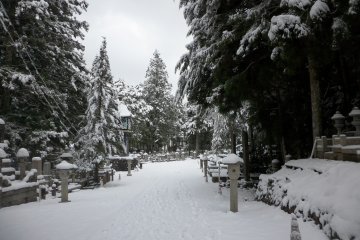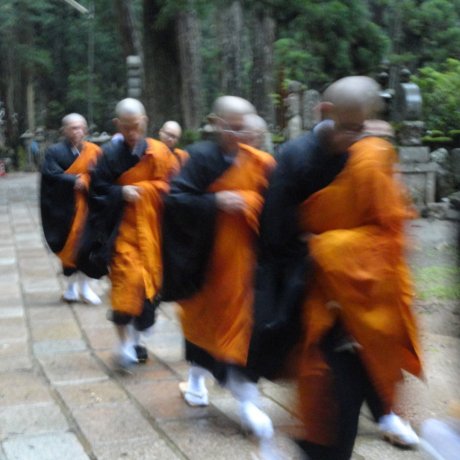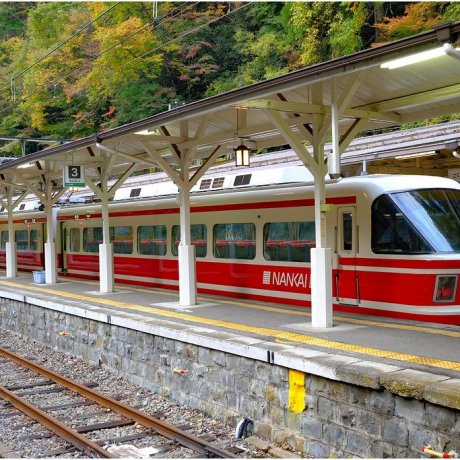Koyasan, or Mount Koya, is a mountaintop sanctuary in Wakayama Prefecture and the center of Shingon Buddhism in Japan, making it one of the most sacred places in the country. In early 800, the famous Buddhist monk, Kukai, also known as Kobo Daishi, founded a Buddhist monastery on the mountaintop as headquarters for the religion. Today, the holy forest is home to a small community of over 100 temples and monasteries, which provide guests opportunities to immerse themselves in Buddhist practices. Detach yourself from the hustle and bustle of Japan’s cities, and rejuvenate your mind, body, and soul on the sacred mountain.
One of Koyasan’s most distinguished structures is Kongobuji Temple, the head temple of Shingon Buddhism. The building’s natural toned facade stands in harmony with the tranquil environment and, inside, features elegant sliding doors that are painted with seasonal flowers and cranes. Take off your shoes and explore the peaceful corridors. Also located on Kongobuji’s grounds is Banryutei Rock Garden, which is Japan’s largest rock garden, containing over 100 large granite stones arranged to resemble two dragons.
Near Kongobuji is the Danjo Garan complex, which marks the center of the area and is the site of Kukai’s original temple. Walk through the temple grounds and observe the sacred structures, including the vermillion painted Konpon Daito Pagoda, which stands bright against the muted foliage.
Truly, Koyasan’s holiest place is its cemetery, Okunoin, which is home to Kukai’s mausoleum. The mystical area is marked by cobblestone paths that weave through moss covered gravestones and ancient cedar trees. Walk through over 1,000 years of history and envelope yourself in the overwhelming sense of peace. To witness the grounds at night, reserve a spot on the Okunoin Night Tour where a monk will guide you through the grounds by torchlight.
Pilgrimage Trails Around Koyasan
Given its religious significance, Koyasan is an ending point for multiple pilgrimage trails and is recognized as a UNESCO World Heritage site due to its inclusion in the “Sacred Sites and Pilgrimage Routes in the Kii Mountain Range.” Trek through the tranquil woods on multi-day or day hikes, and journey the same sacred paths that countless others have done for centuries before.
Most famously, Koyasan is a part of the Kumano Kodo, which is a network of pilgrimage routes in the Kumano region located in southern Wakayama and Mie Prefectures. Koyasan is connected to Kumano via the Kohechi Trail. This multi-day, 70 km hike is a challenging journey through mountainous terrain and should only be attempted by experienced hikers with proper equipment.
Another scenic hiking route is the Choishi-michi, which is a 24 km trail from Jison-in Temple (near Kudoyama Station) to Koyasan. The forested path takes you through mountainscapes and small shrines and is marked by stone signposts (choishi), reminding you of the area’s sacredness. The entire hike takes about 6 to 7 hours, though you can shorten the journey by starting at trailheads closer to Koyasan.
A shorter, yet equally beautiful and impactful hike is the Fudozaka Trail, which starts at Gokurakubashi Station and ends at Fudozaka-guchi Nyonindo temple hall. This 2.5 km, roughly one hour trail is a perfect way to experience a traditional entrance to Koyasan.
How to Get to Koyasan
The quickest and easiest way to get to Koyasan is via private lines. It is possible to reach Koyasan using some JR lines, but the travel time will be longer.
Osaka to Koyasan:
- Take the Nankai Koya Line from Nankai Namba Station or Shin-Imamiya Station to Gokurakubashi Station, which is about a 90-minute train ride. There are some limited express trains that have direct routes, but the more common express and rapid express trains require transfers at Hashimoto Station.
- From Gokurakubashi Station, transfer to Koyasan Cable Car, which will take you up to Koyasan in roughly 5 minutes.
- From there, the town’s center is about a 10-minute bus ride to Senjuinbashi Bus Stop.
Kyoto to Koyasan:
- Take the JR Shinkansen from Kyoto Station to Shin Osaka Station or take the JR Kyoto Line from Kyoto Station to Osaka Station.
- From Shin Osaka Station, hop on the Midosuji Subway Line to Namba Subway Station. From there, you can walk to Nankai Namba Station.
- From Osaka Station, walk to Umeda Station and take the Midosuji Subway Line to Namba Station, and then walk to Nankai Namba Station. Alternatively, take the Osaka Loop Line (a part of JR Rail Pass) from Osaka Station to Shin-Imamiya Station.
- Then, follow steps 1-3 outlined above in Osaka to Koyasan.
Koyasan by train:
- Take the JR Kuroshio train (limited express) from Shin Osaka Station to Wakayama Station.
- Then, take the JR Wakayama line to Hashimoto Station.
- From there, you will have to use the private Nankai Koya Line to travel to Gokurakubashi Station, and then follow the steps 2-3 outlined above in Osaka to Koyasan.
Discount Passes to Koyasan
Koyasan World Heritage Ticket: covers the Nankai Koya Line Line, Koyasan Cable Car, and bus travel within Koyasan and includes discount coupons for some of the sites and souvenir shops. From Nankai Namba Station, two-day round-trip tickets cost 3,400 JPY (includes one-way limited express train to Koyasan) or 2,860 JPY (regular version, does not include limited express train). Buy via Klook
Kansai Railway Pass: covers the Nankai Koya Line and provides unlimited use of trains, buses, and subways in the Kansai region, with the exception of JR trains. Buy via Klook
JR Rail Pass: if you choose to travel via the Osaka Loop Line or JR Kurushio train and JR Wakayama Line to Hashimoto Station, the JR Pass will cover the costs.



































